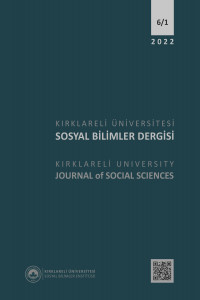TEKNOLOJİ KABUL MODELİ ÇERÇEVESİNDE ÇALIŞANLARIN ELEKTRONİK BELGE SİSTEMİNİ KULLANMAYA YÖNELİK TUTUMU: KAMU SEKTÖRÜNDE BİR UYGULAMA
Teknoloji Kabul Modeli, Teknoloji Kullanımına Karşı Tutum, Algılanan Fayda
___
- Aarts, H., Paulussen, T ve Schaalma, H. (1997). “Physical Exercise Habit: On The Conceptualization and Formation of Habitual Health Behaviours”. Health Education Research, 12(3): 363-374.
- Ajzen, I. (1991). “The Theory of Planned Behavior”. Organızational Behavior and Human Decision Processes, 50: 179-211.
- Ajzen, I. (2002). “Perceived Behavioral Control, Self-Efficacy, Locus of Control, and the Theory of Planned Behavior”. Journal of Applied Social Psychology, 32(4): 665-683.
- Ajzen, I., Fishbein, M. (2005). “The Influence of Attitudes on Behavior”. (Ed: D. Albarracín, B. T. Johnson, M. P. Zanna ve Mahwah, NJ). Handbook of Attitudes. Erlbaum.
- Chiou, J. S. (1998). “The Effects of Attitude, Subjective Norm, and Perceived Behavioral Control On Consumers’ Purchase Intentions: The Moderating Effects of Product Knowledge and Attention To Social Comparison Information”. Proceedings of The National Science Council, 9(2): 298-308.
- Davis, F. D. (1989). “Perceived Usefulness, Perceived Ease of Use, and User Acceptance of Information Technology”. MIS Quarterly, 319-340.
- Fishbein M ve Ajzen I. (1975). Belief, Attitude, Intention and Behavior: An Introduction To Theory and Research. Addison - Wesley, Reading.
- Kalaycı, Ş. (2008). SPSS Uygulamalı Çok Değişkenli İstatistik Teknikleri. Ankara: Asil Yayın.
- Limayem, M., Hirt, S. G. (2003). “Force of Habit and Information Systems Usage: Theory and Initial Validation”. Journal of The Association For Information Systems, 4: 65-97.
- Mutlu S. (2012). Elektronik-Posta Kullanımında, Benimsenmiş Ulusal Kültürel Değerlerin Genişletilmiş Teknoloji Kabul Modeli Üzerindeki Rolü: Demir-Çelik Sektöründe Bir Alan Araştırması. Hacettepe Üniversitesi Sosyal Bilimler Enstitüsü, Yayınlanmamış Doktora Tezi, Ankara.
- Bagozzi, R. P., Yi, Y. (1988). “On The Evaluation of Structural Equation Models”. Journal of The Academy of Marketing Science, 16(1): 74-94.
- Rondan-Cataluña F.J., Arenas-Gaitán J., Ramírez-Correa P.E. (2015). “A Comparison Of The Different Versions Of Popular Technology Acceptance Models”. Kybernetes, 44(5): 788-805.
- Şencan, H. (2005). Sosyal ve Davranışsal Ölçümlerde Güvenilirlik ve Geçerlilik. Ankara: Seçkin Yayıncılık.
- Venkatesh V., Morris M.G., Davis G.B., Davis F.D. (2003). “User Acceptance of Information Technology: Toward a Unified View”. MIS Quarterly, 27 (3): 425-478.
- Venkatesh V., Thong, J.Y.L., Xu X. (2012). “Consumer Acceptance and Use of Information Technology: Extending the Unified Theory of Acceptance and Use of Technology”. MIS Quarterly, 36(1): 157-178.
- Yayın Aralığı: Yılda 2 Sayı
- Başlangıç: 2017
- Yayıncı: Kırklareli Üniversitesi
Gürcan UZAL, Hasan METE, Aytekin ERDEM, Duygu HÜYÜK
İTİKADİ MEZHEPLER TARİHİNİN KAYNAKLARI: İÇERİK VE ÖZELLİKLERİ
KIRKLARELİ’DE YAŞAYAN YERLİ ROMANLARIN SOSYAL KİMLİK ALGILARI İLE İLGİLİ SAHA ARAŞTIRMASI
19.YÜZYIL ORTALARINDA OSMANLI ESNAF TEŞKİLATINA BİR ÖRNEK: BELGRADCIK
GÜLSÜN KARAMUSTAFA’NIN ESERLERİNDE KÖYDEN KENTE GÖÇ VE KİMLİK OLGUSU
POZİTİVİST ANLAYIŞIN SON DÖNEM OSMANLI DÜŞÜNCESİ ÜZERİNDEKİ ETKİSİNE BİR ÖRNEK: ABDULLAH CEVDET
DIŞA AÇILMA VE KAMU HARCAMALARI: OECD ÜLKELERİ İÇİN PANEL VERİ ANALİZİ
THE EVALUATION OF COMPETITIVENESS PERFORMANCE FOR DEVELOPING EIGHT COUNTRIES BY GREY TOPSIS
Bahadır Fatih YILDIRIM, Sultan KUZU YILDIRIM
Selçuk YEKE, Esin Bengü CERAN, Recep İbrahim PINAR
SELÇUKLU-ABBASÎ HANEDANLARI ARASINDA GÜÇ, İKTİDAR VE EVLİLİK İLİŞKİSİ
